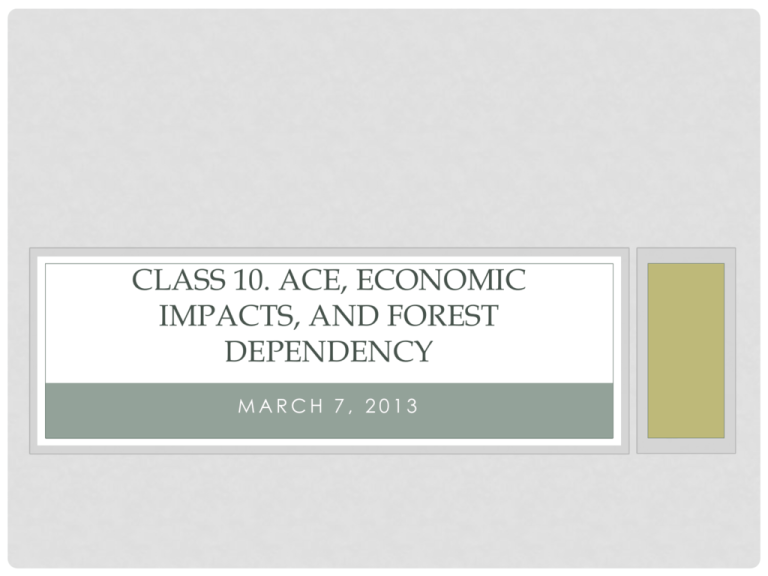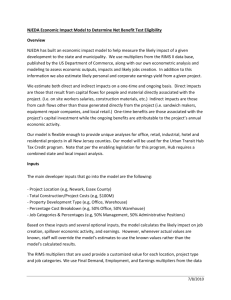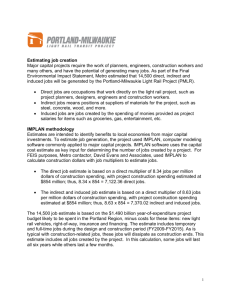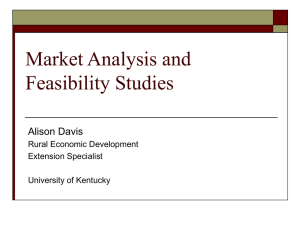Class 10. - FRST 318/537: Forest and Conservation Economics
advertisement

CLASS 10. ACE, ECONOMIC IMPACTS, AND FOREST DEPENDENCY MARCH 7, 2013 ALLOWABLE CUT EFFECT (ACE) • The Allowable Cut Effect exists where there are regulations or policies that constrain harvest levels • Examples in BC are the metering out of old growth timber (key for it to work) • Improvements in growth and yield are spread out over the entire rotation • Conversely losses in timber are also spread out (regardless of whether or not timber was close to harvesting age) USING ACE AS AN INCENTIVE A New Silviculture Framework for British Columbia: Options and Recommendations Report Prepared by Resource Practices Branch Ministry of Forests, Lands and Natural Resource Operations May, 2011 EFFECT OF ACE Standard CBA Effect of ACE • Cost of improving the stand -$1000 per hectare • Result-doubling of growth (an additional 995 cubic metres) • Standard cost-benefit: • If you can take additional volume over the 58 years… ($13,187/58) • Discounted Benefit: $13,187/1.0558=$778 • Cost: $1000 • So NPV =-$222 • Then it looks quite different • Using a formula-the present value of a finite annuity • Result with ACE • Discounted benefit = ($13,187/58)*((1.05)581)/.05*(1.05)58 = $4,546 • Same cost but NPV=$3,546 EXPERIENCE WITH ACE ASSESSING ECONOMIC IMPACTS • Whether for planning or cost benefit analysis we are interested in the economic impacts that flow from different decisions • We can use Input-Output models that show the income an output relationship between different sectors of the economy • This then allows us to determine the economic impacts that follow from an event such as • Change in harvest level, • Construction (or closure) of a sawmill or pulp mill • or a project (such as improving infrastructure/road access) • Often interested in impact on output, employment, government revenues, or GDP BASIC ECONOMY • Remember how the economy works from Econ 100? http://economics.about.com/od/economics-basics/ss/TheCircular-Flow-Model.htm INPUT/OUTPUT MODELS OF ECONOMY • Can use purchases and transactions in economy to develop simplified models that identify relationships between sectors • These input-output models break out these income flows by different sectors and commodities • These can be used to identify the potential impact of one event on a sector in a regional economy and the change in value-added and income earned by primary factors of production DIRECT AND SECONDARY IMPACTS • Direct impacts are associated with the initial change • The secondary impacts follow as those changes work their way through the economy • When a sector expands (contracts) it will buy more (less) from the either sectors • In turn those other sectors will also buy more (less) • The process keeps repeating itself into a new equilibrium is reached BUILDING BLOCK These numbers represent how much of an input is required from each sector to produce output from that sector So for B to produce $1 of output, it needs to purchase 5 ½ ($.055) cents of inputs from sector C; And households (labour) contribute $0.283 for every $1 DERIVING THE COMBINED EFFECT • For $1 change in output of sector A results in a $0.185 change in output for sector B and so on…by the time the new equilibrium is reached, the overall impact from an increase in output by A for $1 for the overall economy will be $1.985 • Different multipliers reflect assumptions about how household income is treated, in-migration of resources, etc. BC MULTIPLIERS • Can be used to derive: • • • • Changes in overall output Employment GDP Government revenue • Application can be tricky BC MULTIPLIERS EXAMPLE (FROM HORNE 2008) IMPACT ON DIRECT OUTPUT • Coefficient shows 2.89 jobs per million$; so dividing number of jobs by direct multiplier then shows decrease in output TOTAL EMPLOYMENT IMPACT • So now look at direct and indirect + SN induced • SN=safety net, and induced counts effect from spending by households AND THEN EFFECT ON GDP… • Again use direct and own indirect and induced • Note that overall impact is summe d up for all three sectors AND GOVERNMENT REVENUES… BC STATS Products and Paper Products sectors are displayed in Tables 7, 8, 9 and 10 where, again, 2004 figures from Appendix B are displayed for comparison purposes. Table 7 – Government Revenue Multipliers: Wood Products Sector excluding fibre inputs – No Safety Net Federal Provincial Municipal Direct Indirect Induced Direct Indirect Induced Direct Indirect Induced 2004 .040 .039 .027 .023 .027 .028 .003 .005 .005 2004A .040 .013 .017 .023 .009 .018 .003 .002 .003 Table 8 – Government Revenue Multipliers: Wood Products Sector excluding fibre inputs – With Safety Net Federal Provincial Municipal Direct Indirect Induced Direct Indirect Induced Direct Indirect Induced 2004 .037 .035 .014 .022 .025 .014 .003 .005 .003 2004A .037 .011 .009 .022 .008 .009 .003 .002 .002 Table 9 – Government Revenue Multipliers: Paper Products Sector excluding fibre inputs – No Safety Net Federal Provincial Municipal IMPORTANT ASSUMPTIONS • • • • • Perfectly elastic supply of inputs All resources fully utilized (at capacity) Quantities (technical coefficients) fixed So Marginal equals average Static, not dynamic I/O APPLICATIONS TO CBA (OR UTILIZING ECONOMIC IMPACTS FROM INPUT-OUTPUT MODELS AND OTHER SOURCES IN COST-BENEFIT ANALYSIS) • Tempting to utilize Value-Added as measure of benefit • But important to realize that those are payments to factors of production • So this is the opportunity cost of utilizing them (since they were employed already) • So net benefit could be zero • But where resources are under-utilized or immobile there could be a net benefit • So under utilized timber resource could earn a residual return that would count as a net benefit • Or if workers were underemployed or unemployed then the increase in wages would count as a benefit • Although this is considered more problematic in the long-term ADDITIONAL FACTORS TO CONSIDER IN CBA • Mobile resources (both workers and capital coming into region) • Economies of scale • Forward linkages aren’t quantified FOREST DEPENDENT COMMUNITIES Mill closures—permanent (total number of mills closed) and indefinite (total number of workers laid off) by province, between January 2003 and December 2009: • • full mill closure jobs lost • Alberta 12 1 722 • British Columbia 75 13 927 • Manitoba 1 190 • New Brunswick 17 3 211 • Newfoundland 3 1 086 • Nova Scotia 3 550 • Ontario 52 10 855 • PEI 1 36 • Quebec 94 14 550 • Saskatchewan 11 1 668 • Total 269 47 795 But had recovered by 32,000 as of Fall 2012 http://www.fpac.ca/index.p hp/en/economicbackbone/ 2006 Economic Dependency Tables for Forest Districts Table 1 – 2006 Employment Estimates by Sector 2006 Economic Dependency Tables for Forest Districts DATE: February 2009 Garry Horne Campbell River Chilliwack North Coast North Island Central Coast Haida Gwaii South Island Squamish Sunshine Coast Fort Nelson Fort St. James Kalum Mackenzie Nadina Peace Forestry Mining & Min Proc Fish & Trapping Agric. & Food Tourism High Tech Public Sector Const Other Non Basic Total 5,551 1,163 1,422 1,586 6,172 193 13,279 3,721 1,626 12,296 47,011 16% 3% 4% 5% 18% 1% 38% 11% 5% 36,411 13,064 6,603 39,878 91,241 62,511 301,571 94,377 205,856 449,071 1,300,581 4% 2% 1% 5% 11% 7% 35% 11% 24% 340 106 1,740 164 1,060 14 2,244 305 523 1,414 7,910 5% 2% 27% 3% 16% 0% 35% 5% 8% 1,618 55 1,007 168 948 59 2,192 369 203 1,157 7,778 24% 1% 15% 3% 14% 1% 33% 6% 3% 354 20 297 17 488 25 891 141 83 455 2,772 15% 1% 13% 1% 21% 1% 38% 6% 4% 14,662 2,144 3,464 5,808 35,468 8,424 107,332 27,871 22,153 93,408 320,733 6% 1% 2% 3% 16% 4% 47% 12% 10% 824 208 62 361 7,559 837 6,598 3,057 1,593 4,844 25,943 4% 1% 0% 2% 36% 4% 31% 14% 8% 3,536 471 894 612 2,503 334 6,323 3,114 1,418 6,780 25,986 18% 2% 5% 3% 13% 2% 33% 16% 7% 802 826 1 33 502 0 679 165 306 616 3,930 24% 25% 0% 1% 15% 0% 20% 5% 9% 839 13 0 51 100 0 625 39 51 147 1,865 49% 1% 0% 3% 6% 0% 36% 2% 3% 1,963 2,400 320 129 1,455 29 4,835 1,021 492 3,360 16,004 16% 19% 3% 1% 12% 0% 38% 8% 4% 1,821 0 0 11 197 6 461 32 75 266 2,867 70% 0% 0% 0% 8% 0% 18% 1% 3% 2,167 139 1 254 507 2 1,379 230 71 921 5,671 46% 3% 0% 5% 11% 0% 29% 5% 1% 2,580 7,728 49 1,845 3,003 57 6,436 3,366 2,187 7,947 35,200 9% 28% 0% 7% 11% 0% 24% 12% 8% • Emphasis on economic dependence ignores other aspects • Aboriginal communities • Tourism not wellrepresented ed by [The University of British Columbia] at 07:26 07 March 2013 BROADER VIEW From Beckley 2008










